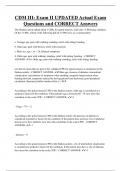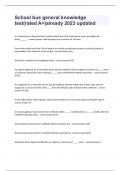CDM III: Exam II UPDATED Actual Exam
Questions and CORRECT Answers
The Haskins article talked about 3 CPRs for spinal stenosis, with only 1 CPR being validated.
Of the 3 CPRs, which of the following did all 3 CPRs have as a commonality?
a. Younger age, pain with walking/ standing, relief with sitting/ bending
b. Older age, pain with flexion, relief with extension
c. Male sex, age < or = 20, bilateral symptoms
d. Older age, pain with walking/ standing, relief with sitting/ bending - CORRECT
ANSWER- ✔✔d. Older age, pain with walking/ standing, relief with sitting/ bending
List the ten items that are part of the validated CPR for spinal stenosis as mentioned in the
Haskins article - CORRECT ANSWER- ✔✔Older age, absence of diabetes, intermittent
claudication, exacerbation of symptoms when standing, symptom improvement when
bending forward, symptoms induced by having patient bend backward, good peripheral
circulation, abnormal achilles tendon reflex, (+) SLR
According to the spinal stenosis CPR in the Haskins article, older age is considered as a
predictive factor for the condition. If the patient's age is between 60 - 70, how does this
contribute to the scale CPR? - CORRECT ANSWER- ✔✔+1
- if age > 70 = +2
According to the spinal stenosis CPR in the Haskins article, the presence of diabetes is
considered a predictive factor for the condition. If the patient does not have a hx of diabetes/
shown not to have diabetes, how does this contribute to the scale CPR? - CORRECT
ANSWER- ✔✔+1
- absence = 0
According to the spinal stenosis CPR in the Haskins article, a hx of intermittent claudication
is considered a predictive factor for the condition. If the patient does have a chx of diabetes,
how does this contribute to the scale CPR? - CORRECT ANSWER- ✔✔+3
,- absence = 0
According to the spinal stenosis CPR in the Haskins article, the patient mentioning that
standing up exacerbates the symptoms is considered a predictive factor for the condition. If
the patient mentions this, how does this contribute to the scale CPR? - CORRECT
ANSWER- ✔✔+2
- absent = 0
According to the spinal stenosis CPR in the Haskins article, the patient mentioning that
symptom relief with bending forward is considered a predictive factor for the condition. If the
patient mentions this, how does this contribute to the scale CPR? - CORRECT ANSWER-
✔✔+3
- absent = 0
According to the spinal stenosis CPR in the Haskins article, the occurrence of the patient's
symptoms being induced with forward bending during the examination is considered a
predictive factor for the condition. If this occurs, how does this contribute to the scale CPR? -
CORRECT ANSWER- ✔✔-1
- if absent = 0
According to the spinal stenosis CPR in the Haskins article, the occurrence of the patient's
symptoms being induced with backward bending during the examination is considered a
predictive factor for the condition. If this occurs, how does this contribute to the scale CPR? -
CORRECT ANSWER- ✔✔+1
- if absent = 0
According to the spinal stenosis CPR in the Haskins article, an easily palpable dorsalis pedis
pulse or an ABI >/= 0.9 is considered a predictive factor for the condition. If this occurs, how
does this contribute to the scale CPR? - CORRECT ANSWER- ✔✔+3
,- if not easily palpable/ ABI < 0.9 = 0
According to the spinal stenosis CPR in the Haskins article, an absent or low achilles tendon
reflex is considered a predictive factor for the condition. If this is found, how does this
contribute to the scale CPR? - CORRECT ANSWER- ✔✔+1
if normal = 0
According to the spinal stenosis CPR in the Haskins article, a positive straight leg raise test is
considered a predictive factor for the condition. If this is found, how does this contribute to
the scale CPR? - CORRECT ANSWER- ✔✔-2
if negative = 0
The Haskins article talked about a CPR rule for spinal stenosis or the "Japanese Society for
Spine Surgery and Related Research Clinical Prediction Rule to Assist in the Identification of
Lumbar Spinal Stenosis". What is the cut off criteria of:
Age
Diabetes
Intermittent claudication
Worse with standing
improvement with forward bending
Worse with forward bending
Worse with backward bending
Peripheral artery circulation
Achilles tendon reflex
SLR - CORRECT ANSWER- ✔✔7 or more --> +
List the criteria used in the validated spinal stenosis CPR talked about in the Haskins article -
CORRECT ANSWER- ✔✔Age
Diabetes
, Intermittent claudication
Worse with standing
improvement with forward bending
Worse with forward bending
Worse with backward bending
Peripheral artery circulation
Achilles tendon reflex
SLR
Based off the Haskins article and its mention of CPRs, what diagnosis may be supported if a
patient in your clinic presents with 2 or more of the following:
- Morning stiffness >30 min in duration
- Improvement in back pain with exercise but not with rest
- Awakening because of back pain during the second half of the night only
- Alternating buttock pain - CORRECT ANSWER- ✔✔Inflammatory back pain
- Based on Berlin criteria
- i.e.: ankylosing spondylitis, psoriatic spondyloarthritis, reactive spondyloarthritis,
spondyloarthritis associated with inflammatory bowel disease, and undifferentiated
spondyloarthritis.
Based off the Haskins article and its mention of CPRs, what diagnosis may be supported if a
patient in your clinic presents with 4 or more of the following:
- Age at onset <40 y
- Insidious onset
- Improvement with exercise
- No improvement with rest
- Pain at night with improvement on getting up - CORRECT ANSWER- ✔✔Inflammatory
back pain






